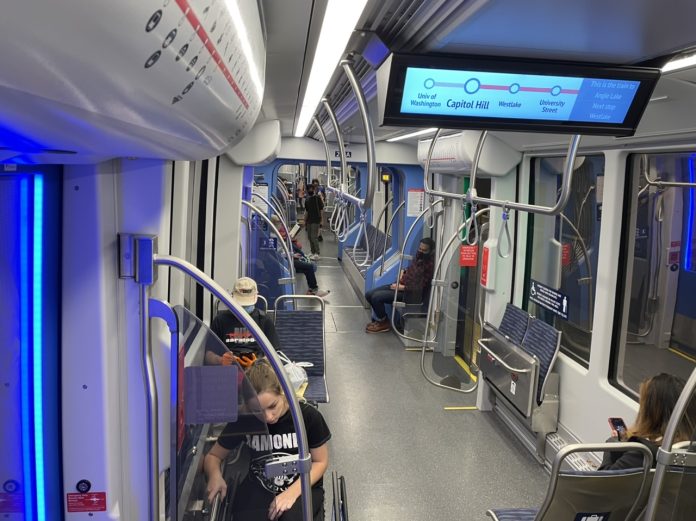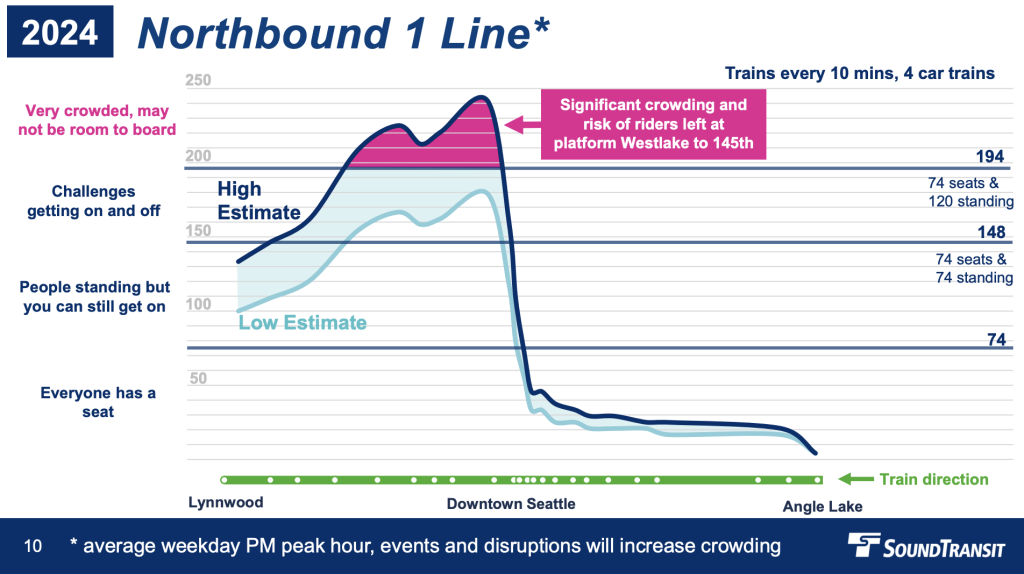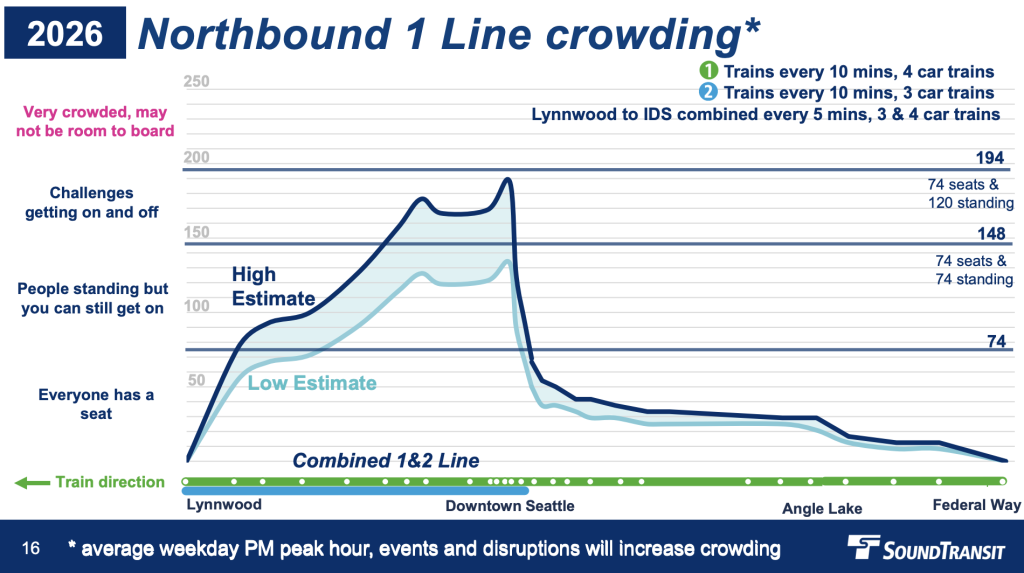
Sound Transit is moving ahead on purchase of 10 more Link cars to buy back some system capacity being stretched and thinned out by Sound Transit 2 expansions. Agency staff say that the extra vehicles will help ensure more trips have four-car trains on East Link (the 2 Line) later in the decade. But purchase of the extra cars still hinges on successful negotiations with Siemens, the Link Series 2 train manufacturer, to build them. A formal purchase agreement will come back to the agency board early next year if Siemens okays the deal.
If all goes according to plan, the extra trains could be put into service by start of the second quarter of 2028. Series 2 trains in the current order of 152 cars are planned to continue delivery and acceptance into service through the end of 2026.
Earlier this year, agency staff unveiled serious service challenges it faces as the Lynnwood Link, East Link, and Federal Way Link Extensions come online. Lack of access to trains stored on the Eastside next year will complicate the initial service plan for Lynnwood Link. The Eastside Starter Line will be a wholly separate operation with its own train fleet until the faulty track on the I-90 bridge is repaired and Line 2 fully opens to Seattle.
Service is expected to degrade next fall on the 1 Line from every eight minutes at peak to every 10 minutes — matching off-peak service — and more trains will operate with three-car trains instead of four-car trains. This risks overcrowding and leaving riders at platforms in Seattle, particularly between downtown stations and Northgate.

Things are expected to improve between Downtown Seattle and Lynnwood once the 2 Line is able to start running through Seattle, potentially in 2025, by essentially doubling frequencies alongside the 1 Line. The 2 Line will only be running three-car trains, but the 1 Line could be restored to four-car trains if all goes well. Overall though, peak frequencies won’t be able to attain the planned eight-minute headways — every 10 minutes may be the best case per line — and crowding could be a common problem in the system core.

At-grade segments are a big pinch point in the system, adding six to eight minutes to trip times on the 1 Line than previously modeled. That added time is weighing down the agency’s ability to deliver frequency and full vehicle capacity per trip as the system expands. Extra vehicles are needed just to maintain the current schedule, compared to if runtimes were shorter. Strategic changes to at-grade segments could speed up trains, but that hasn’t been a focus of the agency’s mitigation work.
Another key problem is that the agency needs more spare vehicles than planned. Sound Transit originally modeled a 15% spare ratio, but now believes it needs to be 20% — in line with industry practices. Those extra vehicles are needed to be on hand for baseline service while out-of-service vehicles go through maintenance and repairs.
Sound Transit settled on 10 extra cars because that’s the number of vehicles that likely could be stored in increasingly tight operations and maintenance facilities (OMFs) in Seattle and Bellevue. The agency told The Urbanist that they could have exercised an option for 16 vehicles, a further six beyond what’s currently contemplated. Those extra trains, however, would need to find storage outside of OMFs, which evidently is why they aren’t being pursued. Nevertheless, the agency previously suggested that it might find storage opportunities at other locations, such as elevated stations.
Purchase of the extra cars is expected to come at a fairly steep price. The agency is allocating $74.2 million for the equipment, an average price of $7.4 million per car. Purchase of the 152 other Series 2 cars was considerably cheaper, coming out to about $4.9 million ($6.1 million in 2023$) per car. The added expenditure will mostly be drawn from funding planned for procurement of the Link Series 3 cars, anticipated for first delivery in 2029 with continued deliveries into 2032, by reducing that order by 10 cars — at least for now.
Earlier acquisition of vehicles does have some slight negative financial capacity implications for the agency’s debt capacity and debt service coverage ratio. Remaining debt capacity is expected to fall from 13.1% to 12.9% and the debt service coverage is to be trimmed slightly from 1.63 to 1.62, edging ever closer to the 1.5 policy minimum.
Had the agency board delayed action on creating a budget action on the 10 extra cars, the agency likely would have missed its opportunity to get the purchase orders in Siemens’ build queue. Those extra vehicles, if successfully procured, will be important for improving service delivery on Link, but insufficient on their own. The agency still needs to figure out how to address a shortage of vehicles for Sound Transit 3 expansions and weigh other mitigation strategies to reduce impacts to riders and deliver on long-standing promises.
Stephen is a professional urban planner in Puget Sound with a passion for sustainable, livable, and diverse cities. He is especially interested in how policies, regulations, and programs can promote positive outcomes for communities. With stints in great cities like Bellingham and Cork, Stephen currently lives in Seattle. He primarily covers land use and transportation issues and has been with The Urbanist since 2014.

